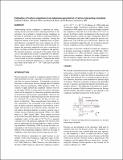| dc.contributor.author | Bakku, Sudhish Kumar | |
| dc.contributor.author | Fehler, Michael | |
| dc.contributor.author | Burns, Daniel R. | |
| dc.contributor.other | Massachusetts Institute of Technology. Earth Resources Laboratory | |
| dc.date.accessioned | 2014-09-29T17:24:45Z | |
| dc.date.available | 2014-09-29T17:24:45Z | |
| dc.date.issued | 2011 | |
| dc.identifier.uri | http://hdl.handle.net/1721.1/90439 | |
| dc.description.abstract | Understanding fracture compliance is important for characterizing fracture networks and for inferring fluid flow in the subsurface. In an attempt to estimate fracture compliance in the field, we developed a new model to understand tubewave generation at a fracture intersecting a borehole. Solving the dispersion relation in the fracture, amplitude ratios of generated tubewave to incident P-wave were studied over all frequency ranges. Based on the observations from the model, we propose that measuring amplitude ratios near a transition frequency can help constrain fracture compliance and aperture. The transition frequency corresponds to the regime where the viscous skin depth in the fracture is comparable to its aperture. However, measurements in the high frequency limit can place a lower bound on fracture compliance. Comparing the model to a previously published VSP dataset, we argue that compliance values of the order 10[superscript −10] −10[superscript −9] m/Pa may be possible in the field. | en_US |
| dc.language.iso | en_US | en_US |
| dc.publisher | Massachusetts Institute of Technology. Earth Resources Laboratory | en_US |
| dc.relation.ispartofseries | Earth Resources Laboratory Industry Consortia Annual Report;2011-11 | |
| dc.subject | Fractures | |
| dc.title | Estimation of fracture compliance from tubewaves generated at a fracture intersecting a borehole | en_US |
| dc.type | Technical Report | en_US |
